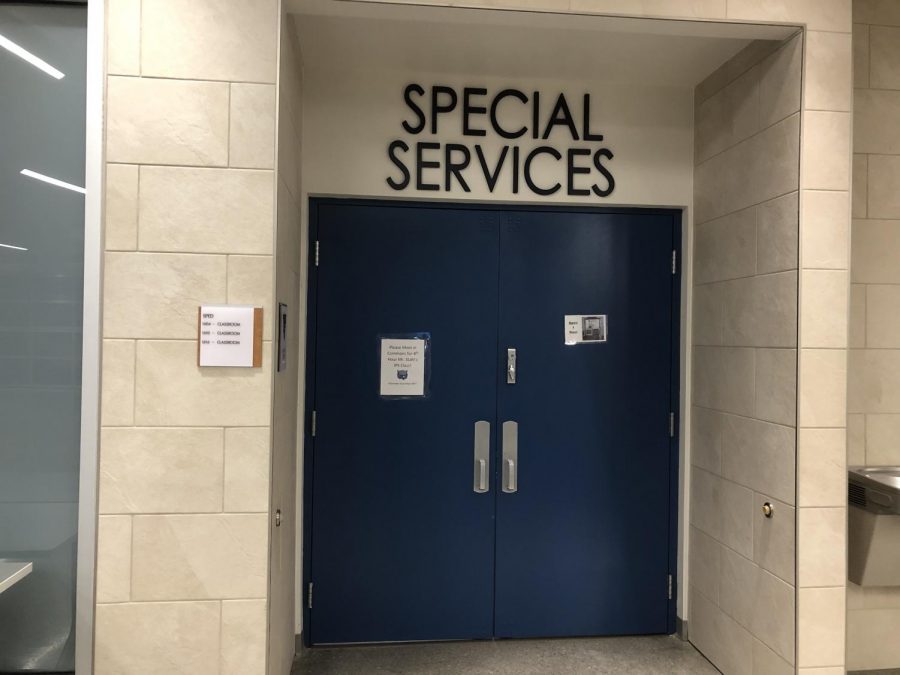Special Education Students and Staff Adapt to Pandemic Challenges
December 18, 2020
While all students have faced many changes and challenges this year, the special education department has had to make even more adaptations to accommodate their students.
It’s been a difficult year for everyone. That pretty much goes without saying. But, it’s been particularly hard on a department that is often overlooked: the Special Education department, or SPED.
The biggest challenge SPED faces is that every kid is different and has different needs. In this sense, dealing with a learning environment that isn’t the norm presents new difficulties for the SPED department and requires it to adapt in order to properly provide the necessary services for its students.
“The nature of special education is that it is indeed specialized,” resource teacher Ashley Admire said. “And so, what that looks like for every single kid is definitely based on their needs and where they are. And we try to meet them where they are and continue to show progress.”
Due to this specialization, the services provided to kids differ as much as the kids do. Accommodations during this unique school year range from kids attending general education classes at home with minimal additional assistance to some kids going to the school building for half, or even a full day.
Students in the Building
Deciding whether or not a student attends school in the building or remains at home this year is “a team decision,” Admire said. “We work with… us as the teachers, the kids, the parents, and then their gen ed teachers.”
Many CBR kids are at school on specific days of the week for a full school day because they need more prompting and assistance than other kids. Some resource kids attend school for half-days, typically based on when they would have Resource and one additional class period.
“We know that some of our kids just will not be able to do what they need to do without having a little bit of that contact in person,” Admire said.
Per pandemic protocol, teachers take care to sanitize tables and materials after students are done using them, to keep everyone safe and healthy.
Students at Home
While there are some students who attend school in-person, most are stuck doing the best they can with the limited resources they have at home. This may include meeting with a resource teacher, like Ms. Hayes, to stay on track and caught up with their learning. This has proven to be difficult, though, as it is hard for teachers to stay on top of students when they don’t even know what they’re doing in their classes.
“For the Special Ed department, our biggest challenge is the difference between remote and in-person students,” Hayes said.” “If students chose to be remote, they have a different set of teachers. No one in our building has to be concerned with those students, even though they are a West kid.”
Resource teachers are working double-time to help out remote students who may not even have teachers at West. This has made communication and collaboration in creating modifications difficult. Having an IEP usually means students have altered learning plans, such as having fewer answer options on a multiple-choice test, or having extended deadlines to turn in assignments.
“Some students have chosen to be remote, but they’re still on my caseload,” Hayes said. “I try to modify their assignments and tests, and that has been really difficult, as well as having access to their grades. I can’t look up their grades very easily and that’s been a really big issue. We can’t minimize the work or follow their IEP very well.”
To solve the issues created by online learning, teachers have been working tirelessly to stay in touch with their students, whether it be by contacting parents or scheduling Zoom meetings with students.
“I spend a lot of my lunch hours working with students,” Hayes said. “My seminars are usually taken up. My plan times are usually taken up. I’ve even gone after school and dropped work off to all of my students. Any sort of accommodation they ask for is what I’ll do.”
Teachers aren’t the only ones working around the clock to keep students focused, though.
“Parents, right now, are our paras,” Hayes said. The parents who get to stay home are sitting next to their students while class is in session, taking notes for them, doing frequent checks for understanding, prompting them to stay involved in class. We’re relying heavily on parents.”
Wearing a Mask on the Spectrum

The pandemic has changed the routine for many special ed classes especially for kids with autism. One big difference is the new mask protocol. It’s been a new challenge for teachers and paras navigating how they can help their students stay as safe and comfortable as possible.
Some kids with autism can have sensory sensitivities that cause them to be irritated by the feeling of having to wear a mask.

Hopebridge Plainfield Center is a place where children on the spectrum can go and receive therapy for whatever their needs are. There, they have been able to help kids get used to wearing masks through occupational therapy.
“When I began working on mask-wearing with Lincoln, I tested him to get a baseline of his tolerance. He was comfortable holding it and touching it to his face, but could not tolerate wearing it properly for more than 15 seconds,” said Board Certified Behavior Analyst Stephanie Shrock.
Through different exercises, Shrock was able to get her Lincoln used to wearing a mask.
“I programmed for him to wear it for small amounts at a time,” Schrock said. “We started at 10 seconds while pairing it with positive stimuli.”
While some kids on the spectrum need extra help to wear a mask, others don’t have as much of a challenge.
“We’ve had a couple that we’ve really worked hard to teach them to wear them here at school, but most of them have just done it,” Olathe West autism teacher Mary Peacock said. “I think because we’re all wearing them it doesn’t seem different to them. They’re doing the same thing we are.”
Another obstacle masks can cause for students on the spectrum is their ability to communicate. Masks muffle your speech and block facial expressions making it difficult for some to receive cues and hear the conversation.
Many of Peacock’s students are non-verbal so communicating with a mask on does not propose a huge issue for her class. Non-verbal students use iPads or other devices to communicate with their teachers and classmates.
The part of communication for these nonverbal students that has most greatly been affected however is body language and facial expressions.
“What I’m finding difficult is when I’m really smiling. I hope they’re seeing it in my eyes,” said Peacock. “I think in my tone they can tell I am light, upbeat and cheerful.”
It’s certainly been a difficult year for the SPED department but they’ve adapted and persevered through the challenges.
“We know that progress may be slowed at this point,” Admire said. “But even at the slowest progress, at least it’s still moving forward and what we don’t want to see is them moving backwards.”
For more information on the Hopebridge Autism Therapy Center visit: https://www.hopebridge.com/blog/tips-to-help-children-with-autism-wear-face-masks

